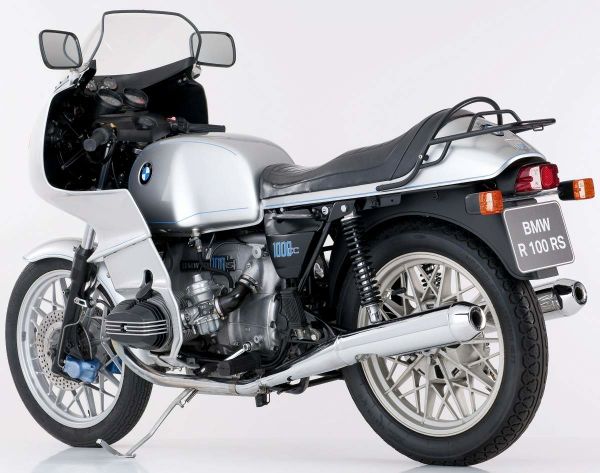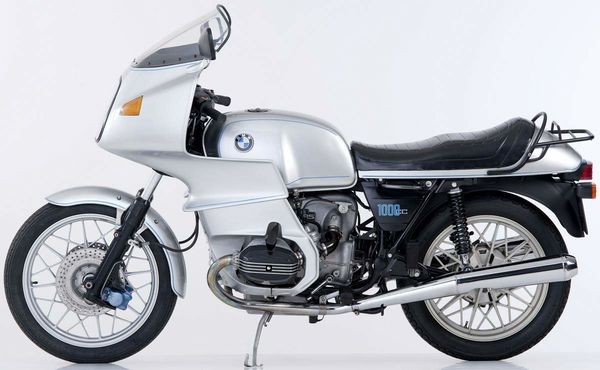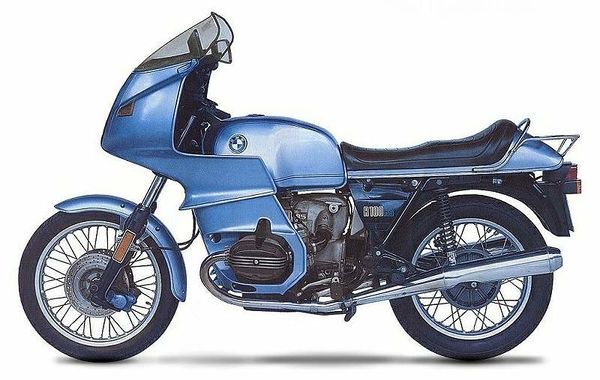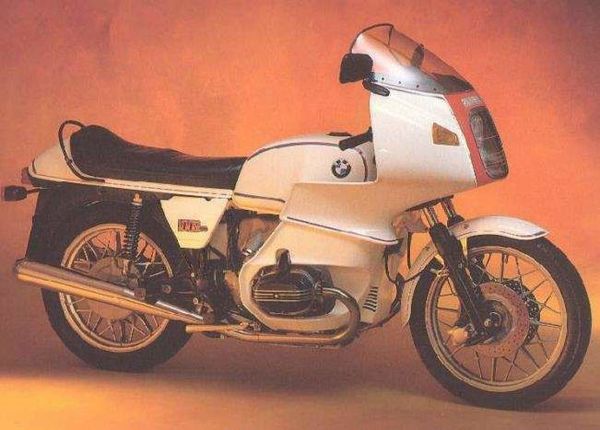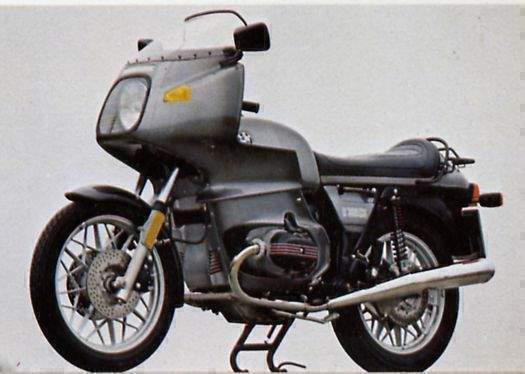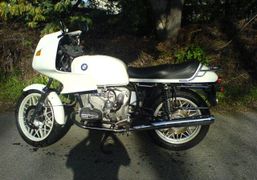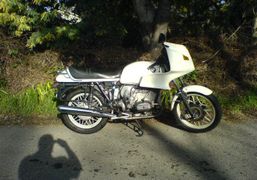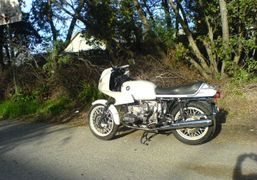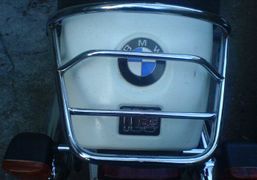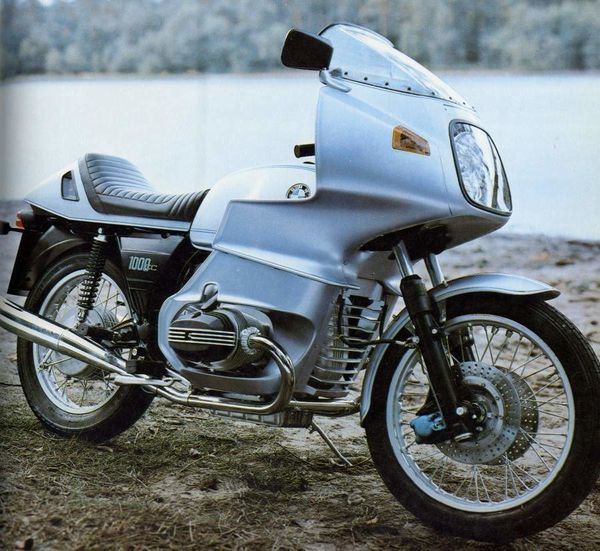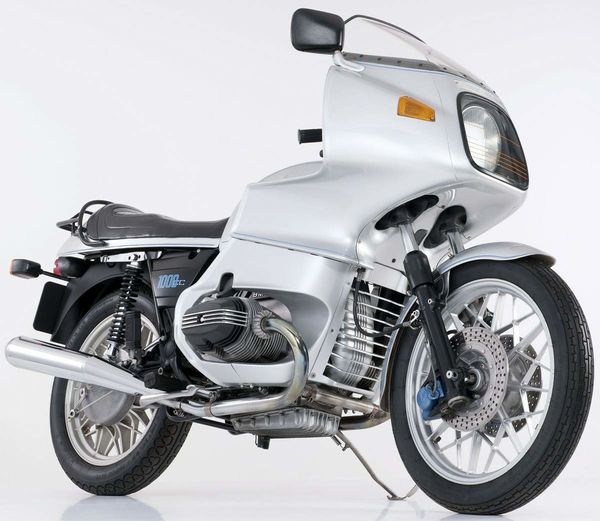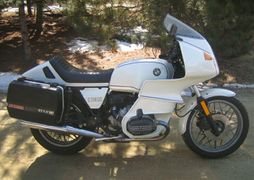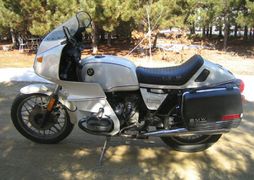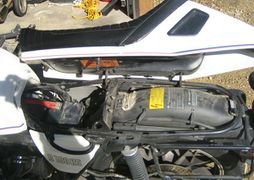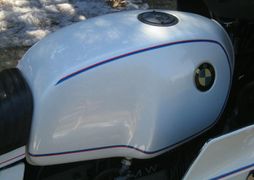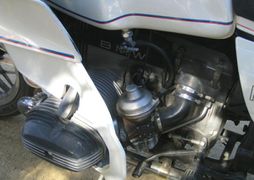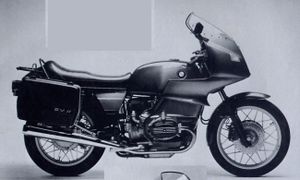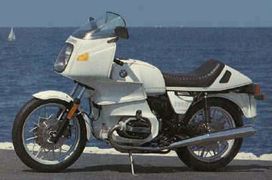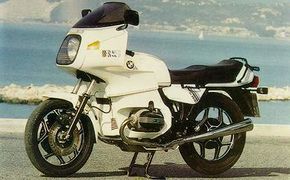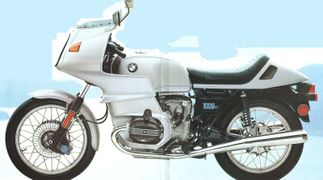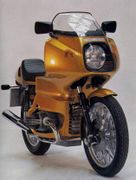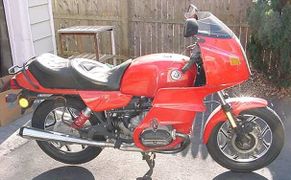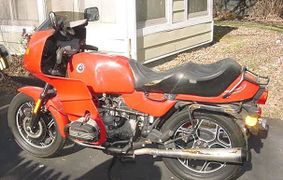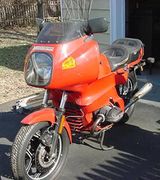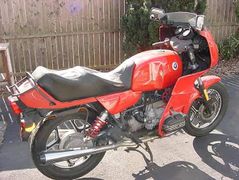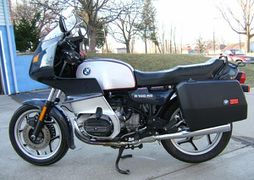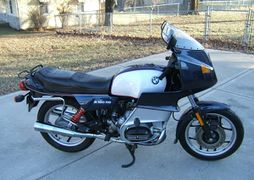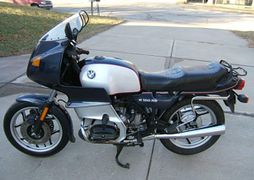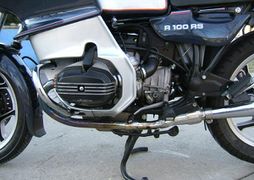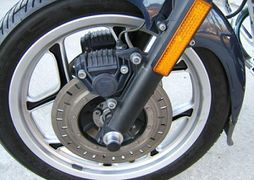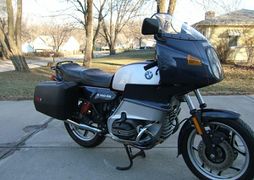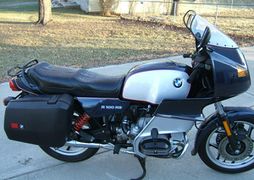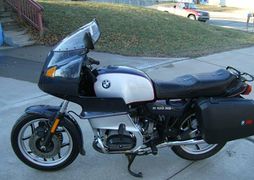BMW R100RS: history, specs, pictures
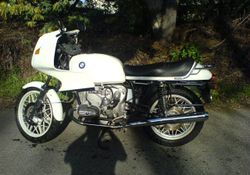 |
|
| BMW R100RS | |
| Manufacturer | |
|---|---|
| Also called | R 100 RS |
| Production | 1976 - 1994 |
| Class | Touring |
| Predecessor | BMW R90S |
| Engine | 979cc two cylinder boxer, four-stroke |
| Bore / Stroke | 94.0mm x 70.6mm |
| Compression ratio | 9.5:1 |
| Top Speed | 108 mph |
| Horsepower | 58.74 HP (43.8 KW) @ 6,500RPM |
| Torque | 56.06 ft/lbs (76.0 Nm) @ 6,000RPM |
| Spark Plug | NGK BP7ES '76-84 NGK BP6ES '88-94 [1] |
| Battery | YUASA YIX30L-BS '76-84 YUASA 53030 '88-94 |
| Transmission | Gear box: 5-speed Clutch: dry, single plate, diaphragm spring |
| Final Drive | Shaft (cardan) |
| Suspension | Front: hydraulic telescopic fork Rear: dual adjustable shocks |
| Brakes | Front: dual disc Rear: expanding brake |
| Front Tire | 90/90-18 |
| Rear Tire | 120/90-18 |
| Wheelbase | 57.72 inches (1466 mm) |
| Length | 83.9 inches (2131 mm) |
| Width | 29.41 inches (747 mm) |
| Seat Height | 32.28 inches (820 mm) |
| Weight | 243.0 kg (wet) |
| Oil Filter | K&N KN-161[2] |
| Fuel Capacity | 5.81 Gallon (22.00 Liters) |
| Fuel Consumption | 42 - 50 mpg |
| Related | BMW R100GS BMW R90S BMW R100S BMW R100RT |
| Manuals | Service Manual |
The BMW R100RS was a two cylinder boxer, four-stroke Touring motorcycle produced by BMW between 1976 and 1989. It could reach a top speed of 116 mph (186 km/h). Max torque was 56.06 ft/lbs (76.0 Nm) @ 6000 RPM. Claimed horsepower was 58.74 HP (43.8 KW) @ 6500 RPM. The R100RS, was heralded as "the most radical-looking motorcycle the modern market has ever seen" quite an accomplishment for stodgy BMW.
History[edit | edit source]
BMW, normally a highly conservative motorcycle company, with very infrequent model changes, and its devotion to its original concept (BMW has used transverse flat-twin power units since the first R32 was built in 1923) could lay the Munich firm open to the accusation that it doesn't innovate. However, nothing could be further from the truth. BMW has often headed some of tile most dramatic developments in the evolution of motorcycles.
Logical Evolution[edit | edit source]
In contrast to the Japanese marques, BMWs strategy is not to emulate successes but to concentrate on the logical, functional evolution of its models. They create without copying. One of their most fundamental steps was made in 1976 with the launch of the R100 RS, a sports/grand touring bike where, for the first time on a machine produced in large numbers, the fairing was not just a bolt on accessory but an integral part of the bike.
Integral Fairing[edit | edit source]
Curiously enough , throughout motorcycling history fairings (at first a simple aluminum shell, then a fiberglass molding, and now made from plastics) and frames have always been poorly integrated. With the BMW R100 RS, the ABS fairing became for the first time an integral part of the machine. There was a high level of Finish on its internal Face including a fully equipped instrument panel and excellent aerodynamics developed in the wind tunnel. The tunnel trials enhanced the bike's performance while giving the rider levels of comfort and protection which remain the standard today.
Engine[edit | edit source]
The engine was a air cooled two cylinder boxer, four-stroke. A 94.0mm bore x 70.6mm stroke result in a displacement of just 979.0 cubic centimeters. Fuel was supplied via a overhead valves (ohv).
Drive[edit | edit source]
The bike has a 5-speed transmission. Power was moderated via the dry, single plate, diaphragm spring.
Chassis[edit | edit source]
It came with a 90/90-18 front tire and a 120/90-18 rear tire. Stopping was achieved via dual disc in the front and a expanding brake in the rear. The front suspension was a hydraulic telescopic fork while the rear was equipped with a dual adjustable shocks. The R100RS was fitted with a 5.81 Gallon (22.00 Liters) fuel tank. The wheelbase was 57.72 inches (1466 mm) long.
First Generation[edit | edit source]
1976 BMW R 100 RS[edit | edit source]
The 1976 MY BMW R 100 RS has, at its heart, an air-cooled, four-stroke, 980cc, boxer twin cylinder powerplant paired to a five-speed manual transmission, and can reach a maximum power output of 70 horsepower and 76 Nm of torque.
This touring machine also comes with a full-fairing with an adjustable windshield, a dual seat, a small luggage rack in the rear, passenger grab rails, die-cast aluminum wheels, a chromed, dual exhaust system, a side-stand, an analogue instrument cluster, a hydraulic telescopic front fork, dual adjustable shocks as a rear suspension and a braking system with dual front discs and a rear drum.
1977 BMW R 100 RS[edit | edit source]
The 1977 MY BMW R 100 RS is a liter-class touring machines that boasts standard fittings such as a full-fairing with a windshield, a dual seat, a small luggage rack in the rear, passenger grab rails, die-cast aluminum wheels, a chromed, dual exhaust system, a side-stand, an analogue instrument cluster, a hydraulic telescopic front fork, dual adjustable shocks as a rear suspension and a braking system with dual front discs and a rear drum.
In the engine department it sports a four-stroke, air-cooled, 980cc, boxer two cylinder powerhouse mated to a five-speed manual transmission that can produce a claimed 70 horsepower and 76 Nm of torque.
The grey (polaris graphit) R100RS illustrated above is not a 1977 model.
1978 BMW R 100 RS[edit | edit source]
The 1978 MY BMW R 100 RS has been designed by the German engineers for those riders who want to spend more time in the saddle. It has, at its heart, an air-cooled, four-stroke, 980cc, boxer twin cylinder powerplant paired to a five-speed manual transmission and can reach a maximum power output of 76 Nm of torque and 70 horsepower.
Also, it comes standard with features such as a full-fairing with a\windshield, a dual seat, a small luggage rack in the rear, passenger grab rails, die-cast aluminum wheels, a chromed, dual exhaust system, a side-stand, an analogue instrument cluster, a hydraulic telescopic front fork, dual adjustable shocks as a rear suspension and a braking system with dual front discs and a rear disc.
1979 BMW R 100 RS[edit | edit source]
The House of Munich has launched a liter-class touring machine especially for Beemer fans (and not only) that want to spent as much time as possible in the saddle, whether solo or two-up, in the embodiment of the 1979 MY BMW R 100 RS. This machine boasts a maximum power output of 70 horsepower and 76 Nm of torque from its air-cooled, four-stroke, boxer two cylinder powerhouse.
In addition, features such as a full-fairing with a windshield, a dual seat, a small luggage rack in the rear, passenger grab rails, die-cast aluminum wheels, a chromed, dual exhaust system, a side-stand, an analogue instrument cluster, a hydraulic telescopic front fork, dual adjustable shocks as a rear suspension and a braking system with dual front discs and a rear disc increase its desirability and make it one of the most sought after motorcycles in its class.
1980 BMW R 100 RS[edit | edit source]
The 1980 MY BMW R 100 RS comes with standard fittings such as a full-fairing with a windshield, a dual seat, a small luggage rack in the rear, passenger grab rails, die-cast aluminum wheels, a chromed, dual exhaust system, a side-stand, an analogue instrument cluster, a hydraulic telescopic front fork, dual adjustable shocks as a rear suspension and a braking system with dual front discs and a rear disc increase its desirability and make it one of the most sought after motorcycles in its class.
In addition, it boasts a maximum power output of 70 horsepower and 76 Nm of torque from its air-cooled, four-stroke, 980cc, boxer two cylinder powerplant paired to a five-speed manual transmission with a shaft final drive.
1981 BMW R 100 RS[edit | edit source]
The House of Munich has designed the 1981 MY BMW R 100 RS for riders on the market for a powerful, fully-faired touring machine, and sports a four-stroke, air-cooled, 980cc, twin cylinder boxer powerhouse mated to a five-speed manual transmission that can produce a claimed 76 Nm of torque and 70 horsepower.
Also, it comes with standard features such as an adjustable windshield, a dual seat, a small luggage rack in the rear, passenger grab rails, die-cast aluminum wheels, a chromed, dual exhaust system, a side-stand, an analogue instrument cluster, a hydraulic telescopic front fork, dual adjustable shocks as a rear suspension and a braking system with dual front discs and a rear drum increase its desirability and make it one of the most sought after motorcycles in its class.
1982 BMW R 100 RS[edit | edit source]
The 1982 MY BMW R 100 RS sports an air-cooled, four-stroke, 980cc, boxer two cylinder engine mated to a five-speed manual transmission, and can produce a claimed 70 horsepower and 76 Nm of torque. It also comes with a high-end suspension package, composed of a front telescopic fork and dual adjustable shocks in the rear, dual front disc brakes and a rear disc brake, full-fairing with a windshield, side panniers, a dual seat, pillion grab rails, a small luggage rack, die-cast aluminum wheels, a large headlight, a center stand and a dual exhaust system.
1983 BMW R 100 RS[edit | edit source]
The German engineers from the House of Munich have designed the 1983 R 100 RS as a powerful, liter-class touring machine, for those riders who prefer the sound and feel of a boxer engine. It has, at its heart, an air-cooled, four-stroke, 980cc, boxer two cylinder powerplant paired to a five-speed manual transmission that produces a claimed 70 horsepower and 76 Nm of torque.
It also comes with features such as a front telescopic fork and dual adjustable shocks in the rear, dual front disc brakes and a rear disc brake, full-fairing with a windshield, side panniers, a dual seat, pillion grab rails, a small luggage rack, die-cast aluminum wheels, a large headlight, a center stand and a dual exhaust system.
1984 BMW R 100 RS[edit | edit source]
The 1984 BMW R 100 RS sports boasts a maximum power output of 76 Nm of torque and 70 horsepower from its four-stroke, air-cooled, 980cc, boxer twin cylinder powerplant mated to a five-speed manual transmission with a shaft final drive.
It also comes with standard fittings such as a front telescopic fork and dual adjustable shocks in the rear, dual front disc brakes and a rear disc brake, full-fairing with a windshield, side panniers, a dual seat, pillion grab rails, a small luggage rack, die-cast aluminum wheels, a large headlight, a center stand and a dual exhaust system.
Second Generation[edit | edit source]
The first-edition BMW R100RS, with many updates focusing on brakes and shifting, and those wonderful cast "snowflake" wheels, lasted through the pearl-white Last Edition models of 1984 when BMW dropped its R100 line and relied primarily upon its K-bike triples and fours to carry it forward. By 1986, the R65 and R80 were the only air-cooled BMW twins left. But the K-bikes were not as popular as BMW had hoped, and there was a worldwide clamor to bring back the 980cc twin.
1985 BMW R 100 RS[edit | edit source]
The 1985 MY BMW R 100 RS comes with a front telescopic fork and single 'monolever' adjustable shock in the rear, dual front disc brakes coupled to a rear drum, full-fairing with a non-adjustable windshield, side panniers, a dual seat, pillion grab rails, a small luggage rack, die-cast aluminum wheels, a large headlight, a center stand and a dual exhaust system.
In the engine department, it sports a four-stroke, air-cooled, 980cc, boxer twin cylinder powerhouse mated to a five-speed manual transmission, that was paired to a five-speed manual transmission with a shaft final drive.
1988[edit | edit source]
1992[edit | edit source]
In Media[edit | edit source]
- The Vanishing
- The Professionals
- Hvem har bestemt?
- Zeder
- Uchû keiji Gyaban
- La gitane
- La trappola
- American Flyers
- The Man with Two Brains
- La voz de su amo
External Links[edit | edit source]
References[edit | edit source]
- ↑ 2019 Western Power Sports Catalog. Western Power Sports. 2019.
- ↑ 2019 K&L Supply Co Catalog. K&L Supply Co. 2019.
| |||||||||||||||||
